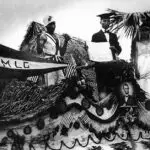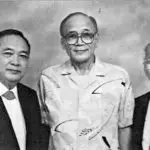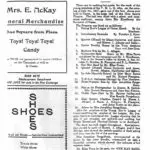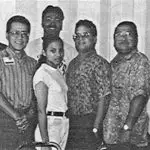Young Men's League of Guam (YMLG)
Table of Contents
Share This
US President was asked to intervene
The Young Men’s League of Guam (YMLG) was formed in 1917 so that CHamorus/Chamorros and Guam Filipinos would have an organization that they could call their own. Its formation, however, came under some heavy opposition. In fact, it took the strong arms of the President of the United States to permit the establishment of a Young Men’s Club in Guam.
In 1916, a small group of young men, headed by Manuel Franquez, Jose Salas, Luis Camacho, Jose de Torres, Francisco L. Guerrero, Manuel Ulloa and Justo Aflague, attempted to form a “Young Men’s Institute,” but obstacles were thrown in their path, primarily by then governor, WJ Maxwell, and Agana’s parish priest, Padre Luís María de León, who felt that such an organization “was not good for my Catholic young men and therefore I advised their parents that they could not let them enter in that society.”
The young men then proceeded to take the matter up with President Woodrow Wilson. In a “confidential” letter to the President dated 1 January 1916, the young men said in part:
We have organized a Young Men’s Institute under which we gather from time to time in the night. Our doings consist of reading newspapers, magazines, books, etc. We also dedicate ourselves to physical exercise, such as gymnasium, boxing, etc. One day Jose Flores Muna, our president, was called by Spanish priest, P. Luís María de León, who told him to have the organization dissolved, and to give heed to the Roman Catholic religion so as not to make confusion.
But as our president expressed himself in a way that he made it understood that (he) was not willing to approve of the dissolution, he abandoned the convent. But shortly thereafter, our president was called by the governor and was told the same thing that P. Luis had told him, and when our president reasoned that the organization was to educate the young men for moral progress (which) was not prohibited by the Constitution of the United States, our president was warned to abandon the organization or be removed from office. (Mr. Muna was the clerk to the civil registry under the Insular Government of Guam.)
Now we earnestly decided for ourselves, and in our name, on behalf of the young men of Guam to address your honor, the honorable President of the United States, to ask (for) your protection of us in our peaceful enterprise and that we be not molested on account of the influence and belief of the Roman Catholic fathers that we may abandon that religion, because under the Government of the United States we feel ambitious in the exercise of free thought.
After a series of consultations between Governor Maxwell, WW Rowley, an advisor to the young men, and the young men themselves, the matter was resolved and the group was formed.
In explaining the purpose of the proposed organization, Rowley, who was later to become editor of the Guam Recorder, a monthly publication, said the objectives of the organization were:
To promote a social intercourse and to improve the moral, physical and standing of those interested. My intentions and also those of the men who were only willing to assist in helping those young men, were, I assure you, honorable from the beginning, there was no intention, nor was there even a thought of attempting to attract the young men’s minds from their church, or from their faith.
In a letter to Rowley, Governor Maxwell pointed out that a formal association must file papers of incorporation with the government, along with a copy of its constitution and by-laws, and that if the association had minors as members (those below 23 years of age) written consent of the parents accepting all legal and financial obligations must be included. The governor added that Rowley must refrain from:
interfering with the exercise of the right of the parish priest to instruct his flock and especially his young men, in accordance with the tenets of their faith, and if the parish priest believes that your organization is one with which Catholic boys should not associate themselves he has a perfect right to say so.
After a brief respite, the organization was finally formed and the name “Young Men’s League of Guam” was adopted. Its basic purposes are expressed in its preamble which, to this day, three generations later, had not changed:
For God and Guam, we associate ourselves together
To promote fellowship, closer understanding among
Fellowmen and to inculcate a sense of individual
obligation to God and country.To encourage active participation all matters
That have to do with the welfare and betterment
Of the people of Guam and the nation.To uphold and defend the principles of good
Government. To assist in every honorable way
In furthering the interests of its members
and their families.To assist and cooperate in the educational and
recreational programs of the Territory of Guam.
Shortly after its formation in 1917, the YMLG gave a stage show as part of the Independence Day celebration at the Cine Gaiety Theater on 3 July. Participants included Joaquin Guerrero, who gave the introductory remarks, a song by a quartet comprised of Misses Gutierrez and Arceo and Mrs. J. Aflague and Sablan; a novelty dance by twin brothers Juan and Jose Cruz; a baritone solo by J. Aflague; a Chamorro steel music composed by J. Manibusan and played by Elias Toves; a one-act play, Fun at the Doctor’s Office, performed by J. San Nicolas, C. Herrero, M. Franquez, and F.L. Guerrero; a Spanish Dance, La Jota, by Mary Torres and Manuel Franquez; a mezzo soprano solo by Josephine Pangelinan; and a piano and violin duet by Rosalia Pangelinan and Roman Sablan.
It was estimated that more than 1,000 people attended the gala event.
First YMLG officers
The first officers of the YMLG were Leon Flores, president; Jose Duenas, vice president; Manuel Ulloa, secretary; and Adriano M. Cristobal, treasurer. The organization’s librarian was Vicente Arriola; its sergeant of arms, Y. Aflague; and its sports manager was Manuel Franquez.
These prominent citizens were the forbearers of some of today’s and yesterday’s community leaders. Leon Flores was born in the Philippines and came to Guam as a political exile in 1901. He was a gobernadorcillo (mayor) in the province of Ilocos Norte and was sent to Guam for refusing to pledge allegiance to the United States. He later assumed the position of Guam’s civil registrar. He was the father of the late Archbishop Felixberto Camacho Flores and the late Senator Leon Flores, who also held the position of Island Attorney.
Jose Duenas, among whose claim to fame was the arduous and dangerous task of keeping tab of the death toll during an influenza epidemic in 1918 when hundreds of people perished, was the father of retired Federal District Court Judge Cristobal C. Duenas and pre-war Attorney Edward Duenas, and the brother of Father Jesus Baza Duenas, renowned both in war and peace.
Manuel Ulloa’s family was eminent in the field of education. Cristobal, also born in the Philippines, was the father of the late Senator Nito Cristobal and Rev. Father Daniel Cristobal, and the grandfather of Superior Court Judge Alberto Lamorena III, and Rev. Father Adrian Cristobal.
Vicente Arriola was the father of former legislative speaker and attorney, Joaquin C. Arriola.
Y. Aflague’s family was prominent in business and in government service. Manuel Franquez became commander of the Guam Militia, which coincidentally, was organized in 1917. Franquez held the rank of colonel.
1917 historical tidbits
Guam’s population in 1917 was 14,142 which included 651 American officers, sailors and their families, 57 American civilians, 104 Japanese nationals, 12 Englishmen, five Germans, 15 Spaniards, and one African American. The person responsible for the census was none other than Leon Flores.
Also organized in 1917 was the first Guam Congress, whose members were appointed by the Naval governor – who was then Captain Roy Smith – and served primarily as an advisory board to the chief executive. The quasi-legislative body was the first ever in recorded Guam history although it had no real legislative authority. The advisory body, which met on Saturdays, did provide a forum for discussion of island issues. Some of the congressional members were also members of the YMLG.
Among prominent citizens who passed away in the 1917 was Jose Herrero, a lieutenant in the Insular Artillery and secretary to the governor during the Spanish regime. Herrero was the son of Jose Ganga Herrero, who served as the governor of Guam from 1823 to 1828. He was the great great grandfather of former governor Joseph Ada, whose mother is Regina Herrero Ada.
Two members of the YMLG got married in 1917 – Simon Sanchez, son of Mr. and Mrs. Candido Sanchez, who married Antonia Cruz, daughter of Mr. and Mrs. Mariano Cruz. The wedding reception was held at the Sanchez home in San Antonio, the easternmost district in the city of Hagåtña.
Also declaring marital vows were Nieves M. Flores and Guadalupe dela Cruz of Sumai by the sea. Their wedding reception was held at the home of the bridegrooms’ uncle, Leon Flores. Nieves Flores was a surveyor who later founded the Guam Institute, a private elementary and high school. Guam’s public library in Hagåtña was named in his honor. Flores’ two sons were Alex, who became the first local editor of the Guam Daily News, predecessor of the Pacific Daily News, and Sabino, who became director of the Department of Labor.
Judges of the Higher Court of Equity included AT Perez and VB Martinez, and judges of the Police Court were Frank Portusach and Antonio Suarez. J. Schnabel was superintendent of Public Instruction.
And burning the baseball paths was Jose (Icha) Guzman, who was hitting at a .384 clip as a member of the Civil Employees baseball team. The team finished the season with five wins and four defeats – not bad when one realizes that some of the Civil Employee’s opponents were among the best the Navy and marines could muster.
In 1918, some of the YMLG members competed in the Guam Baseball League. They were members of the All Natives team and competed against the Navy, the Agana Marines, and the Sumai Marines.
Over the years
By 1924, the YMLG had developed a library, thanks to book donations from its members and other sources, including contributions received from Naval Governor HB Price and Lieutenant PJ Searles. It also formed its own baseball team with Jose B. Salas serving as team manager and Jose M. Perez as team captain.
Jose C. Duenas was elected YMLG president in 1924 but had to relinquish the post because of other duties and business. He was succeeded by Francisco L. Guerrero, with Jose B. Bamba serving as secretary. Duenas had succeeded Francisco Taitano as president.
By 1938, the league had built a handball court behind its building in Hagåtña and invited school children to use it anytime from 3:30 to 6:30 pm, Monday through Friday. The League also leased Alupat Island in Hagåtña Bay (off of Dungca’s Beach) for recreational use and urged the public to use it.
On Sunday, 18 February 1940, the YMLG and the Guam Teachers’ Association met in friendly sports competition with the League winning five of seven events. The YMLG whipped GTA in chong-ka (board game played with small seashells), tug-of-war, softball, straight pool, and checkers. GTA prevailed in acey-deucey (a backgammon variation) and in tennis.
Following World War II, the YMLG was revived, primarily through the efforts of Guam Daily News publisher Joseph Flores, who had the distinction of serving more than five terms as league president. He joined the Navy and left Guam around 1917 and settled in the San Francisco Bay area after his discharge from the Navy. Flores’ able associates included such league stalwarts as Adolfo Sgambelluri, Pete Perez, Joaquin Guerrero, Bill Flores, Felix Camacho, Jose D. Leon Guerrero, Antonio SN Duenas, BP Carbullido, Ben Reyes, Juan Roberto, Jesus F. Perez, Tommy Tanaka and Peter Siguenza.
A new YMLG building was built, a neighboring structure was purchased and various fund-raising activities were held to boost its scholarship fund, and for other altruistic purposes. These events included bingos, raffles and boxing smokers.
In 1961, the YMLG sponsored a benefit boxing smoker at the Paseo de Susana. Results of the fights were: tenejeros Boy of the Philippines whipped Sammy Borja, Kid San Nicolas defeated Paul Sebastian of PI, Galo Taimanglo outpointed Toy Junior, Greg Pangelinan decisioned Noah Sesi, and Pete Pacaigue whipped Rocky Alfonso.
In 1965 and 1966, the YMLG hosted the annual Liberation Day festivities.
A good number of local youngsters were assisted financially by the YMLG through the club’s scholarship fund. Some of the recipients are, or were, holding high positions in government as well as in the private sector.
YMLG member highlights
The league’s roster of members, past and present, is replete with men who have helped guide the destiny of the island.
Guam-born male governors of Guam were all YMLG members. They are Joseph Flores, Manuel F.L. Guerrero, Carlos G. Camacho, Ricardo J. Bordallo, Paul M. Calvo, Joseph F. Ada, Carl TC Gutierrez, Felix P. Camacho and Eddie Calvo.
Two venerable pioneers in the campaign for US citizenship for the people of Guam were league members – Baltazar J. Bordallo and Francisco B. Leon Guerrero. Both were members of the pre-war Guam Congress with Bordallo representing the House of Council and Guerrero the House of Assembly. The two men journeyed to Washington, DC in 1936 and lobbied for congressional enactment of citizenship legislation, but it wasn’t until 1950 when Congress deemed fit to grant American citizenship to the people of Guam.
All three male Guam delegates to Congress were and are members of the YMLG – Antonio B. Won Pat, who represented Guam for twelve years; General Ben Blaz, who served eight years; and Dr. Robert Underwood who served for eight years.
Some of Guam’s most eminent businessmen were league members – Pedro Martinez, Eduardo T. Calvo, Joseph Flores, Pedro M. Ada and Ambrosio Shimizu, among them.
Members of the clergy included the late Archbishop Felixberto Flores and Monsignor Oscar L. Calvo.
Many educators, past and present, were also members of the YMLG, including Simon Sanchez, superintendent of schools; his son, Dr. Pedro C. Sanchez, president of the University of Guam, and commissioner of education at the Virgin Islands and American Samoa; Dr. Wilfred Leon Guerrero, Dr. Jose Cruz, and Dr. Jose Nededog, all presidents of the University of Guam; Luis P. Untalan, B. Carbullido, Tomas R. Santos; Dr. Jeff Barcinas, Victor Artero, Tony Artero, and Dr. Jose (Buddy) Leon Guerrero.
Former members of the Guam Legislature and the Guam Congress that were members of the YMLG include Jose D. Leon Guerrero, Carlito Bordallo, George Bamba, James Butler, Felix T. Carbullido, Bill Flores, Antonio SN Duenas, Alberto T. Lamorena, Pedro B. Leon Guerrero, Manuel U. Lujan, Jesus C. Okiyama, Paul D. Palting, Joaquin A. Perez, Pedro D. Perez, Ignacio P. Quitagua, Manuel G. Sablan, Juan Q. San Miguel, Tomas R. Santos, Tomas S. Tanaka, Juan Tuncap, Raymond Underwood, Mariano Barcinas Santos, and Florencio T. Ramirez.
Former judges who were YMLG members include Jose C. Manibusan, Vicente C. Reyes, Francisco G. Lujan and Vicente B. Bamba.
Guam officials dealing with public safety and security who were YMLG members include Antonio C. Baza, US Marshall; Juan Muna, Selective Service director and colonel in the Guam Militia; Adolfo Camacho Sgambelluri, chief of customs and father of former chief of police, Adolf Sgambelluri; and Juan A. Roberto, a former chief of police as well.
Municipal officers included Luis C. Baza, Sinajana; Jesus S. Camacho, Barrigada; Francisco Chargualaf, Malesso’; Fred Gutierrez, chief commissioner; Vicente A. Limtiaco, Piti; Joaquin D Perez, Sånta Rita-Sumai: Joaquin S. Santos, Asan; and Vicente U. Zafra, chief commissioner.
Other distinguished YMLG members include Jose LG Bitanga, pioneer land surveyor who was said to know every piece of real estate on the island; Felix M. Camacho, father of the late Governor Camacho; Francisco de la Cruz, founder of the Guam Academy of Music; Francisco Terlaje Flores, head of the pre-war Department of Records and Accounts; Joaquin Guerrero, director of agriculture; Luis P. Garrido, godfather of all “ham” radio operators; and Galo Salas, the island’s first treasurer under the Government of Guam.
Other notable Guam residents who were YMLG members are Frank D. Perez, who served both in the pre-war and post-war legislative bodies, and the father of the Guam Economic Development Authority; Adrian Sanchez, who also served in the lawmaking body and a retired senior Navy Chief; Manuel Calvo, former mayor of Yigo; Judge Joaquin Manibusan, whose father, Jose Manibusan, was senior judge of the Island Court; Atanacio (Tas) Salas, an outstanding baseball shortstop in yesteryears; Peter Siguenza Sr., the first Chamorro to become an officer in the Marine Corps; Al Carbullido, the first director of the Guam Housing and Urban Renewal Authority, as well as the first suruhanu; and John Pangelinan, former mayor of Agana Heights.
By Tony Palomo, Peter Siguenza, and Paul Terlaje




